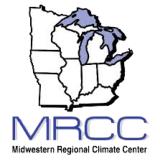Drought Early Warning Update for the North Central U.S.
This drought early warning update was originally sent via email to the Missouri River Basin and Midwest DEWS email lists.
Drought Conditions Persist at the Start of Fall
This Drought Early Warning Update is issued in partnership between the National Oceanic and Atmospheric Administration (NOAA) and the U.S. Department of Agriculture (USDA) to communicate a potential area of concern for drought expansion and/or development within the North Central U.S. based on recent conditions and the upcoming forecast. NIDIS and its partners will issue future Drought Early Warning Updates as conditions evolve.
This covers the following states in the North Central U.S.: Colorado, Illinois, Indiana, Iowa, Kansas, Kentucky, Michigan, Minnesota, Missouri, Montana, Nebraska, North Dakota, Ohio, South Dakota, Wisconsin, and Wyoming.
Key Points
- Extreme drought (D3) continues to persist with some expansion in Colorado, Iowa, and Wyoming, with moderate to severe drought (D1-D2) in every other state except Kentucky and Wisconsin.
- Several wildfires have been burning across areas near the Rockies, and water is limited in many drought-stricken areas for agriculture, livestock, municipal water supply, energy production, and ecosystem services. Dry conditions have stressed agriculture, affected quality and yield in many areas.
- The next week might bring some rainfall to drought areas in the central Corn Belt. However, not much rainfall is in the forecast for the Upper Missouri River Basin, increasing the potential for favorable fire weather through the weekend.
- September precipitation is expected to remain below normal for a majority of the drought-stricken areas in the central U.S. As a result, fire could continue to be an issue during harvest for mature crops in the worst drought areas across the central U.S. Fall planting (winter wheat, canola, cover crops) could be delayed or affected.
Current Conditions and Impacts
- Extreme drought (D3) continues to persist with some expansion in Colorado, Iowa, and Wyoming, with moderate to severe drought (D1-D2) in every other state except Kentucky and Wisconsin.
- The recent expansion and intensification of drought has been driven by widespread below-normal rainfall (only 10-50% of normal) and a recent spell of hot temperatures. Soil moisture percentiles are very low in a large swatch stretching from Nebraska east to Ohio.
- Several wildfires have been burning across areas near the Rockies, including wildland and grassland fires in Colorado, Montana, Nebraska, South Dakota, and Wyoming. Several burn bans have been put into place.
- Water is limited in many drought-stricken areas for agriculture, livestock, municipal water supply, energy production, and ecosystem services, resulting in management actions like hauling water, supplementing navigational flow in the Missouri River Basin, city water restrictions, and utilizing emergency water supplies. Water quality has also decreased due to drought.
- Corn and soybean conditions have worsened quickly in Iowa and are drying down prematurely reducing some yields. Grasses are also very dry and in poor condition, and dry soils are affecting the ability to establish fall cover crops. Also, some specialty crops are seeing reduced production/quality changes.
Outlook and Potential Impacts
- Precipitation within the next week may bring some rainfall to drought-stricken areas (Iowa, Illinois), however moving into mid-September (Sept 11-17), precipitation is expected to remain below normal for a majority of the central. U.S.
- Temperatures are likely to turn significantly below normal for the region, which would be beneficial to reduce evaporative demand of the already-stressed soils.
- There is an increased potential for favorable fire weather conditions in the Upper Missouri River Basin through the weekend. As fall progresses, fire could be a concern in areas that are extremely dry especially during harvest.
- Soil moisture recharge is important for next growing season but also for fall seeded crops (winter wheat, cover crops, canola), which could lead to poor establishment and potential yield loss next growing season. Grasses/rangeland also need moisture to start recovery in the fall. Some specialty crops (i.e., apples) can still make use of September rainfall.
- Soils are very dry and in need of fall recharge in a wide area of the Corn Belt. Additional rains are needed to recharge some limited water supplies in Iowa.
Prepared By:
Molly Woloszyn & Britt Parker
NOAA/National Integrated Drought Information System (NIDIS)
Dennis Todey & Dannele Peck
USDA Midwest and North Central Climate Hub
Doug Kluck
NOAA/National Centers for Environmental Information
Ray Wolf
NOAA/National Weather Service
Natalie Umphlett
High Plains Regional Climate Center
Mike Timlin
Midwestern Regional Climate Center
In partnership with the National Drought Mitigation Center (NDMC) and American Association of State Climatologists (AASC).









